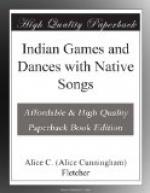Indian games that depend upon chance, according to Dr. Culin, may be divided “into those in which the hazard depends upon the random fall of certain implements employed, like dice, and those in which it depends upon the guess or choice of the player; one is objective, the other subjective.” Games of the first or objective class are generally played in silence, while those of the second or subjective class, called guessing games, are accompanied by singing. (Ibid., p. 44.)
In a game where the two sides contest, as in a ball game, the sides were frequently played by two different tribes or by two villages in the same tribe. In such cases the players often went through a course of training in order to prepare them for the contest. Bathing, exercise and diet had to be followed according to prescribed custom. Among the Cherokee the partaking of rabbit was forbidden, because the animal is “timid, easily alarmed and liable to lose its wits”; so if the player ate of this dish, he might become infected with like characteristics. Mystic rites were sometimes performed to prepare the player so that he would be successful. (Ibid., p. 575.)
According to the Indian belief, the pleasure of games was not restricted to mankind but was enjoyed by birds and animals. The following story from the Cherokee is told by Mr. James Mooney and quoted by Dr. Culin (Ibid., pp. 578, 579):
“The animals once challenged the birds to a great ball play. The wager was accepted, the preliminaries were arranged, and at last the contestants assembled at the appointed spot—the animals on the ground, while the birds took position in the tree-tops to await the throwing up of the ball. On the side of the animals were the bear, whose ponderous weight bore down all opposition; the deer, who excelled all others in running; and the terrapin, who was invulnerable to the stoutest blows. On the side of the birds were the eagle, the hawk and the great Tlaniwa—all noted for their swiftness and power of flight. While the latter were preening their feathers and watching every motion of their adversaries below, they noticed two small creatures, hardly larger than mice,




